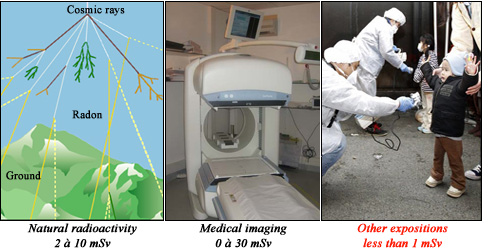A unit for low doses of radioactivity
After a nuclear accident or accident of radioactivity, it is often question of millisieverts. What is a millisievert? What means this amount, this unity, mysterious to the uninitiated, generally associated in his mind to harmful health hazards.
The millisievert is a radioprotection unit measuring the radiation dose received either from a radioactive source or from other sources like X-rays in medicine. This is generally a whole body effective dose, but it may also be an equivalent dose received by a particular tissue or organ.
The millisievert is the unit used for very low doses. For instance, humans are not very radioactive, but the dose resulting from the internal radioactivity of their bodies amounts to 0,25 millisievert or mSv. A dose of 1 mSv should not generate excessive anxiety. Effects on human health are observed only beyond 100 mSv. It takes thousands of millisieverts it takes thousands of millisieverts dose to cause injuries that can be fatal in the short term.

Three sources of millisieverts …
Radiation protection distinguishes the source of exposures to radiation. There are no limits for millisieverts resulting fron natural radioactivity, because one can not do otherwise. There are also no limits for doses in medical imaging or therapies. On the contrary, regulations imposes a limit of 1 millisievert for miscellaneous other exposures, including those arising from accidents. This limit is far below the natural doses or those resulting from imagery in medicine.
© IN2P3
In radiation protection, the regulation distinguishes three kinds of millisieverts: millisieverts due to natural radioactivity, millisieverts due to medical imaging, millisieverts due to miscellaneous other causes.
Millisieverts due to natural radioactivity do not bother about any regulation. The average dose from natural radiation is 2.4 mSv in France, but it varies from one place to another. It can reach a dozen mSv or more in some regions such as the beaches of Kerala in India and parts of Brazil and Iran.
Medical imagery millisieverts of on the increase on the development of diagnostic techniques. In France, they are approaching on average 2 mSv per year. In Japan, the country with the most centenarians, the average is 5 mSv per year. These exposures vary greatly with the health condition. A scan of the abdomen expose to around 10 mSv, a thallium scintigraphy may reach 30 mSv. There are no limits for diagnostics that can screen cancer and save lives. But, these examinations should be justified and optimized. Advances in detection techniques is the best weapon for dose reduction.
Regulations limit exposures due to other causes to less than 1 mSv per year for the general public. Apart from the case of accidents, these third type are well below this 1 mSv limit. For example, the dose resulting from a Paris-New York flight is 0.030 mSv, the impact of nuclear power in France is around 0.010 mSv per year and inhabitant.
The cells of human bodies does not distinguish between the three types of millisieverts. An upper limit of 1 mSv for the doses of the third type may seem an illusion if natural or medicine doses vary easily of several millisieverts from one place to another and one individual to another. It is as if during a driving alcohol tests, the police was cautioning against a modest glass of cider while turning a blind eye to a calvados or whiskey breath !
The regulatory limit for the doses of the Third Type was steadily reduced over the years and now stands at the very low value of 1 mSv. The purpose of this continuous reduction is to reduce exposure risks, especially in the case of an accident like Fukushima, in virtue of the Precaution Principle. However, one should keep in mind that for doses of the order of millisievert actually very low, the health effects are also very low if any. These effects may exist. They should not be a source of excessive anxiety.
Other articles on the subject « Radioactive Doses »
Radioactive Activity Doses
Becquerel or Bq : the activity unit of a radioactive source The activity of a sample of matter wh[...]
Absorbed doses
Gray or Gy : unit of energy deposited in matter by radiation The ‘absorbed dose’ is defined as th[...]
Biological doses
Sievert (Sv) : the unit of doses for the living The energy deposited in a living organism by radi[...]
Equivalent Dose
A local biological dose The concept of the “equivalent dose” which takes into account[...]
Effective Dose
A full-body dose, central in the field of radioprotection The “effective dose” is a b[...]
Dose Scale
A dose classification for acute exposures When dealing with exposure to radiations, what do we me[...]